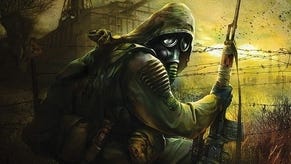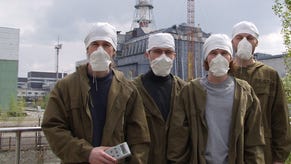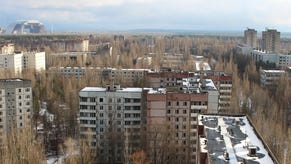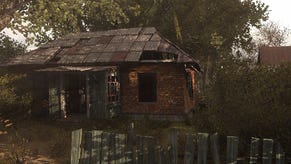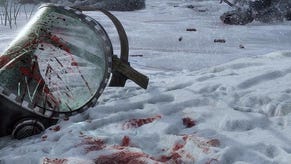S.T.A.L.K.E.R: Shadow of Chernobyl
Radioactive Reed braves the exclusion zone once again to bring you the latest fallout on GSC's stunningly beautiful first-person shooter...
For all the screenshots and video footage, STALKER may still have some convincing to do. After all, we know it's graphically beautiful and wrapped around the premise of a post-disaster Chernobyl, but how does it actually play? We've been all the way to Kiev and back to try and see for ourselves, but we're still waiting for significant gameplay revelations, leaving us to rely on measured optimism. We'd love to get carried away with the stupendous visuals, but we've been burned too many times - the best we can do is hope that it blossoms into a game to match the quality of the environments, and prove GSC Game World's various doubters wrong - in style.
NVIDIA certainly has enormous faith in the product, championing it as a poster child for its relentless The Way It's Meant To Be Played campaign, while its financial backer THQ is quietly expecting even greater things. And all this from a game devoid of licensing and due out exclusively on the PC. What is this? 1998? We haven't heard such forward-looking, risk taking vision from a US firm in years. "Yes, STALKER is the big one for this Christmas," a THQ exec happily confides during E3. But despite such boldly enthusiastic proclamations amid the chaotic din of the show floor, he admits "the pressure's on".
On time, or whenever?
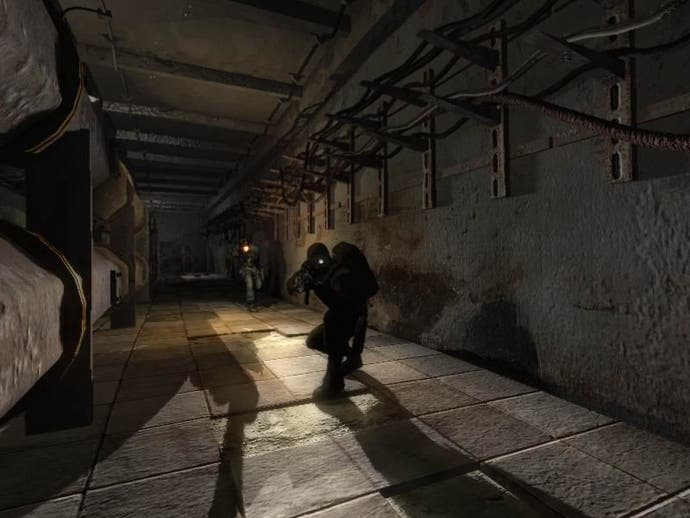
Knowing full well that the game could slip, while being careful not to make those kind of frank admissions or even daring to speculate, THQ knows that not only does it have to rely on the relatively unproven talents of GSC to deliver the game on time, but for the Ukrainian developed game to hit the mark in terms of gameplay as well. With much of the project seemingly coming together at the last minute, it really is anyone's guess whether the internal expectations - that have long since marked GSC's debut first-person shooter out as something special - are in any way realistic.
Leading us inside to calmer, saner, quieter portion of the THQ stand, we're brought to a tiny room the size of a broom cupboard where GSC's head of communication Oleg Yavorsky is busy giving demonstrations of the first DirectX 9 build of the game, which is an order of magnitude more impressive than the DX 8 build being shown off in the theatre downstairs.
You'd think they'd be screaming about it, but as Yavorsky explains, the demo is all rather ad-hoc, with even THQ not expecting to be able to show off the game's new tech in time for E3. Only a hastily transferred FTP upload hours before the show allowed GSC to show off what owners of top-end graphics cards can expect when the title ships later in the year.
At this stage, Yavorsky was only able to walk us through a small portion of the game's inner hub - the sarcophagus of the ruined reactor, complete with a few of the game's mutated nasties - but it was more than enough to illustrate how much further the game has come since we last saw it in February, and also the benefits of DX 9 tech over DX 8. The most staggering advances were made in lighting and shadowing, with scenes of poor light now rendered to an incredible degree of realism. Even in almost total darkness it was possible to pick up on minute levels of detail thanks to some very deliberate, but subtle use of light sources. "All the lighting you see in STALKER is processed dynamically," says Yavorsky. "We use per pixel lighting, and there are no lightmaps used at all. Everything you see is all calculated in real time".
Danger! Overused superlative!
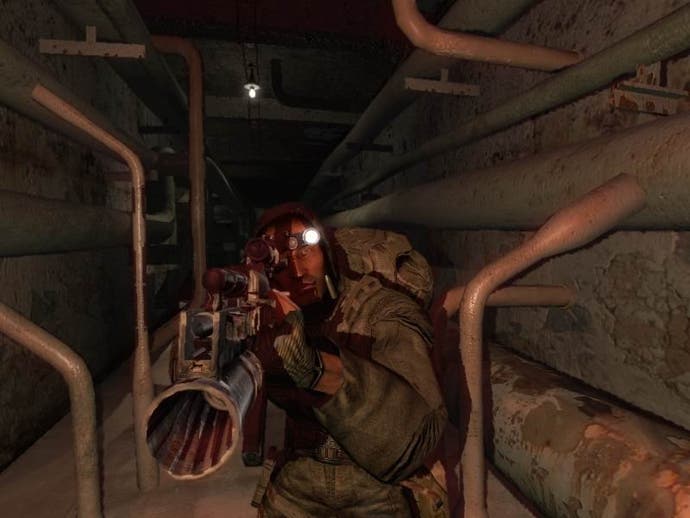
Wandering around to a blazing fire in the core of the reactor (as you do) a delightful heat distortion effect washes over the screen. "It's extremely dangerous here," he notes. It looks it. If the term 'visceral intensity' is starting to feel overused, then at least save it for describing this game. The tiny effects in action have massive gameplay implications, potentially creating whole new types of tension-based gaming in the hands of the right designers.
"Any light source casts a huge shadow in front of it, and this adds a lot to the atmosphere when you see a huge shadow of a monster coming from behind or from round the corner for instance," Yavorsky says as he demonstrates the lighting effect. "A really tiny creature can show up and give the illusion of being this giant being - it really adds a lot of tension to the gameplay when you don't quite know what to expect."
But given that this is the Sarcophagus and has been in ruins for decades, who's paying the electricity bill? "Something hidden is still going on!" he laughs, "That's the story - this place also has mysteries behind it." Aha, a Scooby Doo mystery. Those pesky meddling kids again?
Maggie Philbin presents...
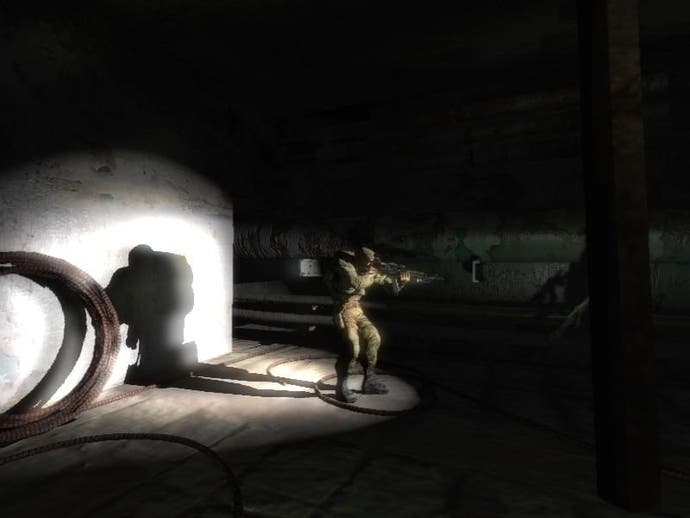
After that, Yavorsky shows us how shadows fall through transparent objects. "It's technically quite challenging," he says. "You have shadows cast through the alpha channel." As much as we'd love to know what that means, it's a lovely effect to see a slowly spinning fan cast entirely accurate shadows onto everything that comes into their path. How much of this game will involve sightseeing is open to speculation, but it's often staggering to peer into the future, Tomorrow's World style.
On top of this, there's a convincing layer of physical interactivity - and all GSC's own handiwork. A modicum of destructibility is promised, and we're given a brief look at the physics when Yavorsky shoots a door and it swing back and forth on its hinges, while shooting the light bulb cord not only sends it all over the place, but creates its own temporary dynamic light show.
The character models, too, have all been radically improved since we last saw them, with a particularly fearsome foe called a Bloodsucker capable of simulating invisibility Predator-style to quite a terrifying effect. One or two others are shown off, and it's clear that some work has gone into bringing them up to the standard of the rest of the game, although a question mark obviously still lingers over the quality of the AI.
Another excuse to upgrade
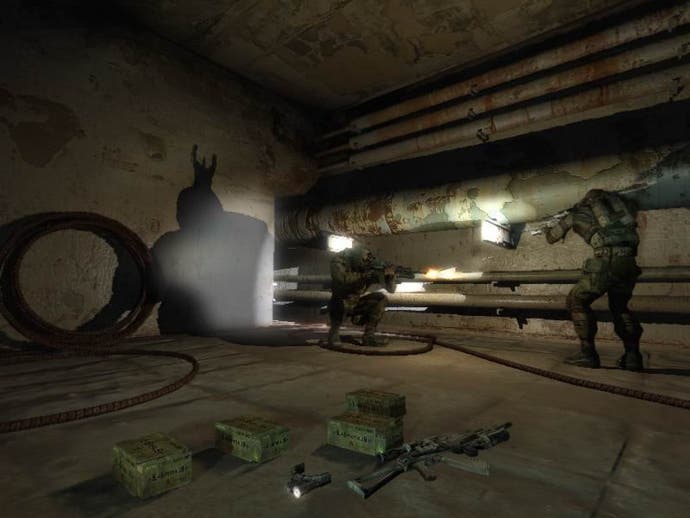
All this graphical frippery is great, there's no question of that, but we were wondering what owners of GeForceFX or GF4 generation cards might miss out on? "Well, for a start, the game will ship with DX 8 and 9 renderers and the game will adapt automatically to what you've got, so it will scale to the available power. What do you lose? A gigantic number of polygons as well as soft dynamic shadows and soft lighting and this heavy bump mapping. On DX 9 cards we're running up to three million polygons per frame." Unbelievably, the demo unit runs at just 800x600, but you'd swear it was double that.
All PCs are not born equal, this much we know, but GSC and THQ are acutely aware that many potential purchasers will have already have performed their upgrades post Half-Life 2 and Doom III, and see it as being the perfect companion product to make the most of gamers hungry to make the most of their ninja PC configurations. And why not? It's been something of a barren period for gaming in terms of maxing out the PC's capabilities, and now seems as strategically a good a time to do something as all out benchmark as any.
Surely GSC will be licensing out the tech to other devs, Id and Epic style? "Yes we have plans," he admits. You bet they have. It's a game engine that will shape the way many games will look on next gen consoles - and Yavorsky agrees it would work well on fifth generation tech. "We'd like to focus on the PC version for now, and after that we'll think of the possibilities of porting it to something else - we'll see." But it's definitely one that would work well on the next gen consoles? "Yes, yes, quite possibly". With the next round of consoles not expected until 2006, don't be surprised to see this among the early titles released on the PS3 or Xbox 2.
Candyman
With all the DX9 demo taking place indoors, we're wondering what enhancements to expect in the expansive outdoor sections: "Visually it's just more eye candy - essentially the shaders and use of bump mapping, soft lighting, really more realism to it. Effectively it's just graphical enhancements."
All along, THQ has been gunning for September release, but you can basically forget that. GSC isn't so confident. Asked when it will emerge on the shelves, Yavorsky delivers a nervous "Errrr..." before plumping for the safe waters of "this year we'll release!" before qualifying that with "yeah, but we don't want to push it!" and ending with the dreaded FPS kiss of death: "once we're done, we're done". But you're definitely going for a Christmas release? He nods. We hope he's right. The radiation might take us by then...
S.T.A.L.K.E.R is currently scheduled for release on the PC "before Christmas".


